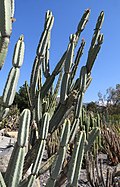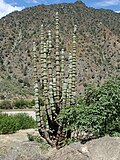This article uses parenthetical referencing, which is deprecated on Wikipedia . |
| Armatocereus | |
|---|---|
 | |
| Armatocereus rauhii subsp. balsasensis | |
| Scientific classification | |
| Kingdom: | Plantae |
| Clade: | Tracheophytes |
| Clade: | Angiosperms |
| Clade: | Eudicots |
| Order: | Caryophyllales |
| Family: | Cactaceae |
| Subfamily: | Cactoideae |
| Tribe: | Echinocereeae |
| Genus: | Armatocereus Backeb. |
| Type species | |
| Armatocereus laetus | |
| Species | |
See text | |
Armatocereus (from Latin armatus, "armed" and cereus, "pliant/soft") is a genus of mostly tree-like cacti from South America (Ecuador and Peru). These species have a conspicuous constriction at the end of the annual growth. The flowers are mostly white, with a more or less spiny ovary. The fruits are mostly spiny.





